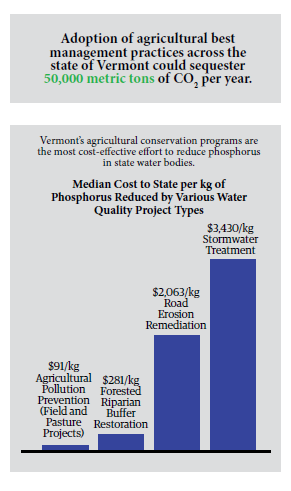Editor’s note: This brief is part of the Vermont Agriculture & Food System Plan 2021-2030 submitted to the legislature in January 2021. To read the full plan, please go to
Lead Authors: Nancy Everhart, Vermont Housing & Conservation Board | Alissa White, University of Vermont
This brief is based on the multi-stakeholder Payment for Ecosystem Services Working Group report.

What’s At Stake?
Ecosystem services are the “ecosystem functions that are useful to humans.” Agricultural landscapes in Vermont can be managed to enhance ecosystem services such as nutrient cycling, climate regulation, biodiversity, and cultural identity.
Compensating farmers for providing these additional benefits to society beyond food production via a payment for ecosystem services (PES) program would financially recognize farmers’ contributions to meeting pressing environmental goals such as the Lake Champlain Basin Total Maximum Daily Load plan, Greenhouse gas emissions reductions, and flood resilience, and also enhance the viability of farms committed to environmental stewardship. However, creating a viable PES program to make transformative change will require policy and regulatory changes and new sources of capital, as well as technological, programmatic, and market developments that do not currently exist.
Current Conditions
A payment for ecosystem services program is premised on the idea that actions to improve or sustain ecosystem services should be economically quantified and rewarded. Farmers and conservationists in Vermont see PES as an innovative tool to enhance ecological stewardship and complement existing conservation incentive programs available to farmers. Current conservation programs typically solve environmental concerns by paying farmers for the implementation cost of discrete, prescriptive practices, as do most U.S. PES programs (e.g., the Conservation Reserve Program). Farmers in Vermont are interested in developing a PES program which instead pays for performance, as an opportunity to receive payment for services provided, learn more about the specific ecological impacts of management changes on their farmland, and recognize and reward the initiative, ingenuity, and knowhow of farmers who have already invested in conservation
practices.3 A PES program in Vermont would make payment contingent on the steady provision of services such as water purification, flood mitigation, aquifer recharge, erosion control, and biodiversity.
Due to the initiative of farmer-led Watershed Coalitions and UVM Extension, in 2019 the Vermont Legislature established a Soil Conservation Practices and Payment for Ecosystem Services Working Group, which focused on soil health as the foundation to multiple ecosystem services. Designing a PES program which balances the goals and needs of all stakeholders is challenging. Multiple efforts are underway to determine what to measure, how to measure, how to structure payments, and how to balance efficiency with fairness, while allowing farmers the flexibility to innovate and adapt.
Bottlenecks & Gaps
• Scientific research has established strong and reliable links between soil health and many ecosystem services, but the relationship between soil health and water-nutrient pathways requires more research.
• Farmers, researchers, and technical advisors need to build consensus on how to quantify performance of ecosystem service provisioning.
• It is unclear what payment scheme will best achieve balance between rewarding farmers already invested in conservation and making greater environmental gains.
• Reliable and long-term private and/or public funding sources need to be identified.
• The costs, logistics, and best entity to administer a PES program are all unclear, and stakeholders may not agree on the path forward.
Opportunities
• There are existing and emerging technologies that can be modified or utilized to measure performance and outcomes.
• Improving ecosystem services can reduce future costs for individuals, municipalities, and the state, through reducing the severity of flood risk, reducing nutrient loading into surface waters, and slowing the pace of climatic change. These avoided costs can be estimated, and it is often more economical to invest in ecosystem services preemptively.
• Existing public funding could support a pilot PES effort in Vermont. Strong interest across the country in PES may lead to private markets and funding for ecosystem services more broadly.
• The Vermont Environmental Stewardship Program (VESP) has enrolled several farmers and can be used to educate, engage, and prepare farmers for a future PES approach.
Recommendations
(These recommendations are based on the multi-stakeholder PES Working Group report.)
• Continue to support the Payment for Ecosystem Services Working Group, which is poised to be a central point of coordination and connection among the many needed research and design efforts. These efforts should focus on PES approaches that regrow or sustain Vermont’s natural resource base so that it provides at least three ecosystem services: water quality, flood resilience, and climate stability. Estimated cost: $90,000.
• Undertake an evidence-based review of existing research on soil health, to advance understanding of soil health and the services it provides. Research by what metrics soil health should be measured and identify the ecosystem services that arise from those metrics. To be led by UVM. Estimated cost: $30,000.
• Fund independent research to review, evaluate, and compare existing tools for PES monitoring and modeling which could be used in Vermont. Then, identify, describe, and provide an initial evaluation of new and emerging technologies and programs for measuring and monitoring ecosystem services. Potentially performed by UVM. Estimated cost: $30,000.
• Based on the research reviews noted above, prepare a Request for Proposals for the development of a specific tool to quantify multiple ecosystem services from Vermont farms, which draws on real-time data and monitoring to pay farmers for producing clear, measurable outputs. Estimated cost: $250,000.
• Expand the Vermont Environmental Stewardship Program (VESP) to provide farmer participation stipends for benchmarking and education. Estimated cost $50,000.
• Sustain funding for existing programs which enable farmers to invest in the management changes that lead to increased ecosystem services. This includes cost sharing, grants, technical assistance, education, easements, and the Current Use tax incentive.

